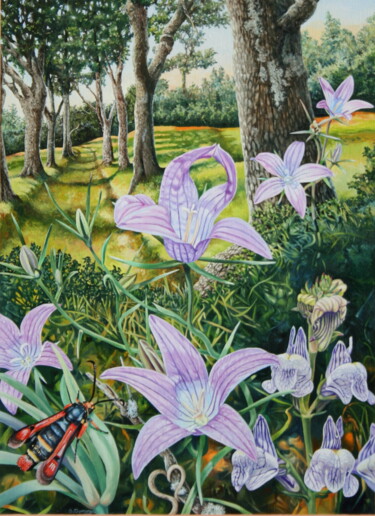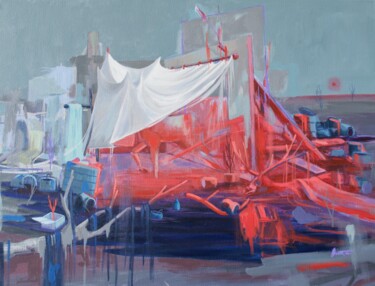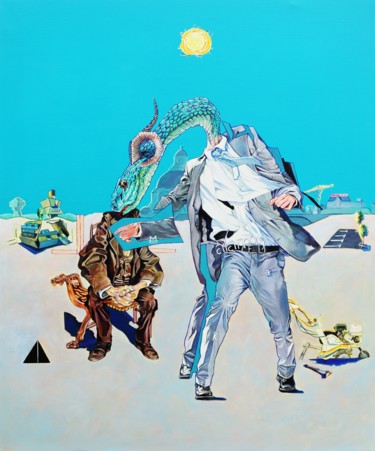 Applestrophe, Planet apple global warming protection, 2018. Acrylic on linen canvas, 160 x 130 cm.
Applestrophe, Planet apple global warming protection, 2018. Acrylic on linen canvas, 160 x 130 cm.
Art and nature: an indissoluble bond
The link between art and nature, although it has changed drastically in its forms, purposes and expressions over the centuries, has always been strong, to say the least, indissoluble. Initially, artists turned their eyes to the natural world simply to draw inspiration from it, carefully immortalizing its beauty, in a sort of "celebration" of creation. This intention has been expressed according to multiple points of view, indelibly linked to the major currents of artistic expression of all times, such as, for example, classicism, romanticism and impressionism. In fact, classicism focused on exalting the rural and historical dimension of nature, romanticism the grandiose and wild, while impressionism investigated the sensitive and poetic research of the reality that surrounds us. Only later, and more precisely with the advent of the inexorable changes brought to the world by industrialization, did art gradually become a means of denouncing the fragility of the environment, setting aside its pure aestheticism. The new and more innovative approaches to the natural subject were redefined during the twentieth century with Land art, Recycled art and Ecological art, although only the latter two, in most cases, represent explicit and harsh messages in favor of the protection and preservation of the environment.
 Gary Waters, World band aids, 2020. Digital art, several formats available.
Gary Waters, World band aids, 2020. Digital art, several formats available.
 Jean Claude Causse, Brent God of Energy, 2008. Sculpture, metal / resin / terracotta on metal. 80 x 45 x 45 cm.
Jean Claude Causse, Brent God of Energy, 2008. Sculpture, metal / resin / terracotta on metal. 80 x 45 x 45 cm.
Ecological art
Ecological art, born in the nineties of the twentieth century, starting from trends dating back to the late sixties, represents an artistic genre moved by the purpose of denouncing the global environmental crisis, through a strong exhortation to the protection, preservation and restoration of life forms and resources of the earth. In fact, Ecological art innovatively merges aesthetics with information and education, striving to promote environmental awareness and the restoration of nature. It is important to emphasize how the aforementioned intent is expressed through a wide range of artistic methodologies, such as sculpture, painting, photography, video art, assemblage, environmental installation, environmental sculpture, poetry, cinema, land restoration art, reclamation projects, etc. Finally, added to this expressive richness are the multiple approaches to the environmental topical, which can: reveal information with the intention of stimulating dialogue, seek to recover or restore the environment, want to excite and activate behavior change, spread sustainable lifestyles, and share information about environmental injustice and ecological problems.
 Алекс Вознесенский, Garbage. Brought by the sea wave..., 2013. Oli on canvas, 60 x 60 cm.
Алекс Вознесенский, Garbage. Brought by the sea wave..., 2013. Oli on canvas, 60 x 60 cm.
 Pol Attard, Mona Lisa Carbon, 2021. Collage / carbon / tape on canvas, 81 x 65 cm.
Pol Attard, Mona Lisa Carbon, 2021. Collage / carbon / tape on canvas, 81 x 65 cm.
Artmajeur artists: some examples of ecological messages hidden behind their works
Many Artmajeur artists have developed, within their own varied artistic investigation, eco-friendly themes, aimed at highlighting the impending environmental crisis. Artistic methodologies include photography, painting, sculpture, collage and digital works, which have addressed the aforementioned topics issues with focus on marine pollution, the fate of Mother Nature and the human species, the deterioration of green spaces and many other aspects. Surely, it is good to underline how, thanks to the sensitivity and inspiration of each artist, the environmental theme always appears not monotonous, distinguishing itself for its originality and innovativeness, able to amaze us, involve us and sensitize us on this important subject.
 Starmonkeyz, Our lady of the polluted seas, 2016. Photography on synthetic panel, 120 x 160 cm.
Starmonkeyz, Our lady of the polluted seas, 2016. Photography on synthetic panel, 120 x 160 cm.
Starmonkeyz: Our lady of the polluted seas
The importance of creativity emerges strongly in the photograph of Starmonkeyz, where, to talk about marine pollution, a personification is used, immortalizing on film a soft mermaid, sympathetically lying on a pile of garbage. This ironic vision brings a smile that, immediately after, is accompanied by the bitterness of awareness, because Our Lady of the Polluted Seas, as also stated in the brief description of the artist, is a clear reference to those 634,000 kilos of waste, which are dumped into the oceans every second.
 Cbaud, Dead fish, 2020. Digital photography on paper, 58,5 x 39 cm.
Cbaud, Dead fish, 2020. Digital photography on paper, 58,5 x 39 cm.
Cbaud: Dead fish
In Cbaud's photograph, in order to allude to marine pollution, a dead fish has been cleverly captured on the sand, becoming a symbol, as well as a reminder, of what the planet may become if climate change continues to impose itself. The power of photography emerges to the fullest in this work, where with a precise shot, a studied subject and a meaningful context, a clear message is generated for those who, ready to listen, find the time to associate an image with one of the greatest dramas of our time.
 Cassiopeia, The Call of Mother Nature, 2021.Digital photograph, 60 x 40 cm.
Cassiopeia, The Call of Mother Nature, 2021.Digital photograph, 60 x 40 cm.
Cassiopeia: The Call of Mother Nature
In the provocative and significant shot of Cassiopeia, Mother Nature, personification of nature, giver of life and nourishment, protects herself from Covid-19 by wearing a mask. Most likely this work wants to launch a clear warning message to men: the world, exasperated by human intervention, is getting out of hand even to those who created it, who now must protect themselves from new and catastrophic events. Vladislav Sernov, Hope, 2019. 2D digital artwork / Photomontage / Digital painting on paper, 50 x 70 cm.
Vladislav Sernov, Hope, 2019. 2D digital artwork / Photomontage / Digital painting on paper, 50 x 70 cm.
Vladislav Sernov: Hope
The artworks of the artists of Artmajeur have not only shown the current consequences of the environmental crisis, but have gone further, imagining the damage it could bring in the future. In Vladislav Sernov's digital photomontage, entitled Hope, it is precisely the becoming of a bad ecology that causes new and disturbing forms of mankind and the world. In fact, the snapshot is set in a hypothetical and desolate context, which, strongly dark and lonely, is enlivened only by the rose petals brought by a sudden gust of wind.
 Giò Cascone, N-ovum, 2021. Painting, acrylic / chalk / pigments on canvas, 90 x 73 cm.
Giò Cascone, N-ovum, 2021. Painting, acrylic / chalk / pigments on canvas, 90 x 73 cm.
Giò Cascone: N-ovum
The artist Giò Cascone wanted to symbolically fight the current environmental crisis, painting a work full of hope, in which a tree, colorful and strong, is able to grow luxuriantly despite the overheating of the earth and human misconduct. This message has been enriched by the presence of an egg that, contained in a nest inside the foliage of the plant, is a symbol of the unlimited regenerative capacity of nature, a quality stronger than any adversity.


 Olimpia Gaia Martinelli
Olimpia Gaia Martinelli



































